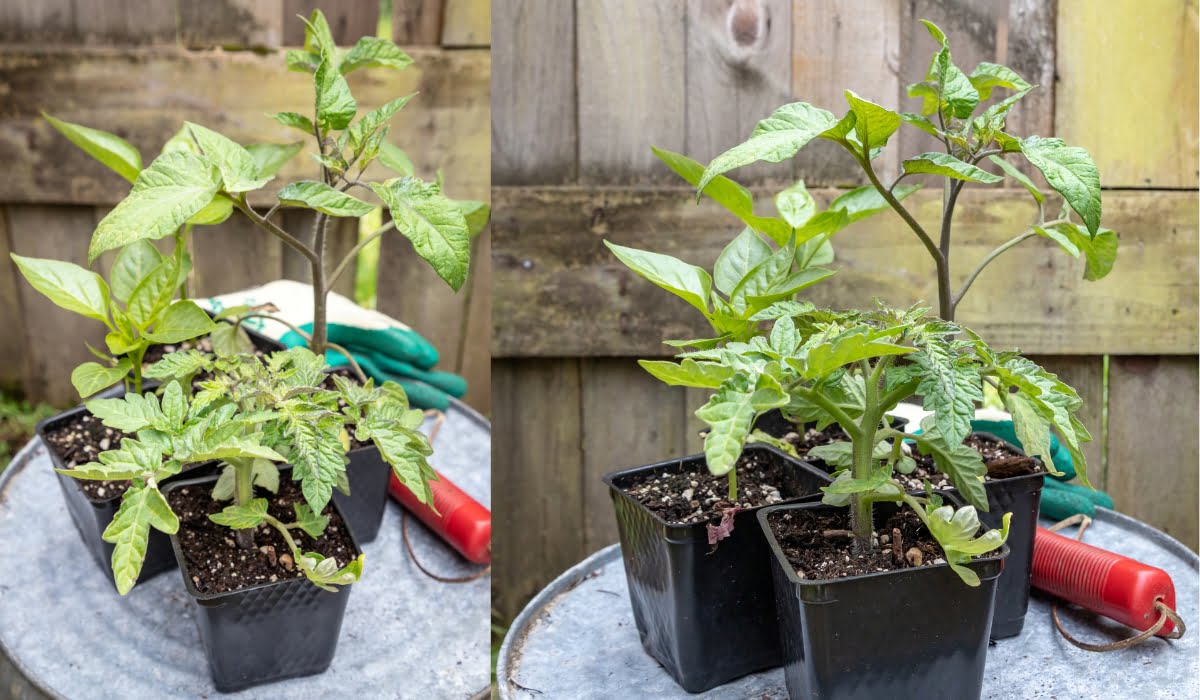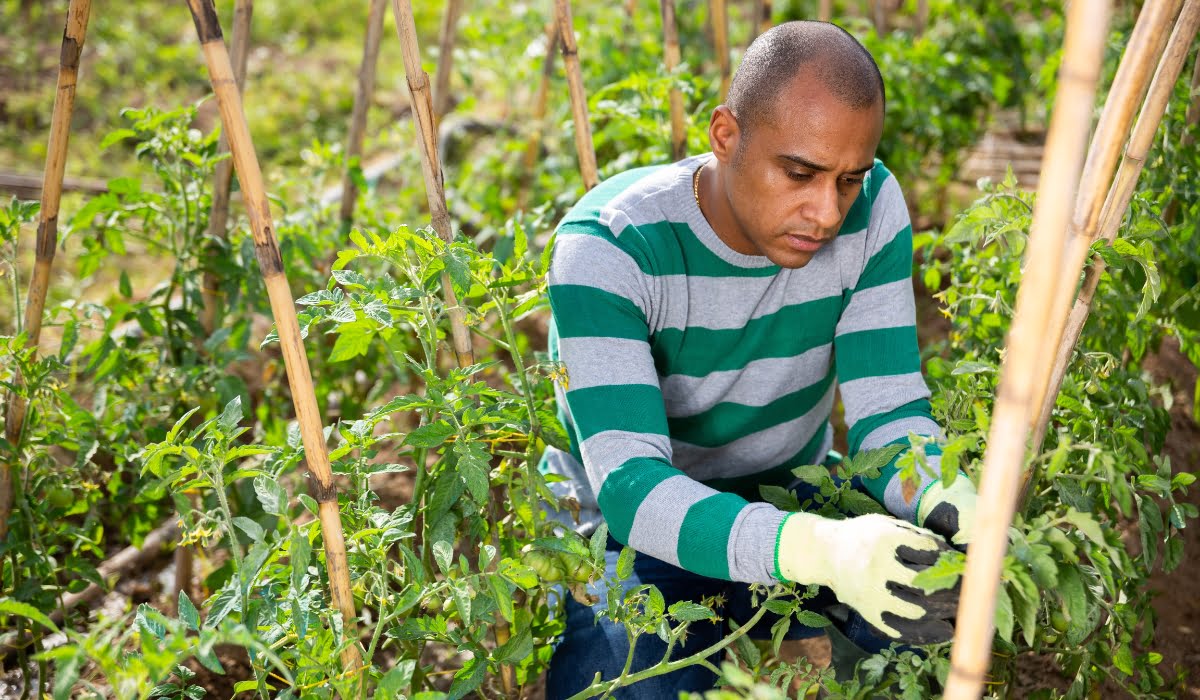Introduction to Growing Tomatoes in India
Are you prepared to start a trip to cultivate your own tasty tomatoes in the convenience of your kitchen garden?At Shehri Kisaan, we believe that the joy of plucking sun-ripened tomatoes straight from the vine is an experience every Indian gardening enthusiast should savor. We will walk you through the process of growing tomatoes in a kitchen garden in this extensive guide, offering you insightful information, advice, and methods. Let’s dive in and discover the intriguing world of tomato cultivation!
1.1 The Popularity of Tomato Cultivation in India
With their brilliant colour, tart flavour, and nutritional value, tomatoes have a special position in Indian cuisine. Tomatoes are very popular among Indian home gardeners because of their adaptability and vast application.. The satisfaction of growing your own tomatoes, knowing they are free from harmful chemicals and pesticides, is a compelling reason why many enthusiasts are embracing tomato cultivation.
1.2 Benefits of Growing Tomatoes at Home
Growing tomatoes in your kitchen garden offers numerous benefits beyond the sheer joy of harvesting your own produce.Let’s look at some of the benefits that make growing tomatoes a great option for Indian home gardeners.
- Nutritional Benefits: Tomatoes are a great source of important vitamins, minerals, and antioxidants that support a balanced diet.
Flavour and Freshness: Homegrown tomatoes enhance the flavour of your culinary creations with their remarkable flavour and freshness. - Cost-Effectiveness: Growing your own tomatoes at home might ultimately save you money because store-bought tomatoes can be expensive, particularly during busy seasons.
- Control over Growing Environment: Growing tomatoes in your kitchen garden gives you complete control over the growing environment, ensuring the best circumstances for strong plant growth.
- Educational Experience: Engaging in tomato cultivation provides a valuable learning opportunity, teaching you about plant life cycles, gardening techniques, and sustainable practices.
Choosing the Right Tomato Varieties for Indian Climates
Selecting the appropriate tomato varieties that thrive in Indian climates is crucial for a successful harvest. Let’s explore some of the best tomato varieties for different regions in India.
2.1 Best Tomato Varieties for Warm Indian Climates
In regions with warm climates, it’s essential to choose tomato varieties that can withstand high temperatures and prolonged periods of sunlight. Here are some recommended varieties:
- Roma Tomato: Ideal for making sauces and pastes, Roma tomatoes are known for their meaty texture and excellent heat tolerance.
- Cherry Tomato: Perfect for snacking and salads, cherry tomatoes are small, flavorful, and heat-tolerant.
- Pusa Ruby: This Indian variety is well-suited for warm climates and produces medium-sized, juicy tomatoes.
2.2 Suitable Tomato Varieties for Colder Regions in India
If you reside in colder regions of India, selecting tomato varieties that can withstand lower temperatures is crucial. Consider the following varieties:
- Early Girl: This variety is known for its ability to produce fruit even in cooler conditions. It matures relatively quickly, making it suitable for areas with shorter growing seasons.
- Tropical Ruby: Developed specifically for tropical and subtropical regions, this variety adapts well to both warmer and cooler climates.
- Pusa Hybrid: Pusa Hybrid tomatoes are well-suited for colder regions, as they have a good tolerance to low temperatures.
Preparing the Soil for Tomato Planting
Checking the pH levels of your soil is the first step. Tomatoes typically grow best in soil that is between 6.0 and 6.8 pH and is somewhat acidic. For assistance, utilise a soil testing kit or get in touch with your neighbourhood agricultural extension office. You can adjust the pH of the soil if it is too high or low.

You can include organic material like compost, well-rotted manure, or pine needles to boost acidity (lower pH). To establish the best conditions for the growth of tomato seedlings, the soil must be properly prepared before planting. Here are the essential procedures to follow when getting the soil ready for your kitchen garden.
3.1 Testing and Amending Soil pH Levels
Incorporating elemental sulfur or coffee grounds into the soil can also help lower the pH levels. If the soil is too acidic, you can raise the pH by adding lime or wood ash.
3.2 Adding Organic Matter to Improve Soil Fertility
Adding organic matter to your soil is essential for improving its fertility, drainage, and water retention capabilities. It enhances the overall structure of the soil, allowing the tomato roots to penetrate easily and absorb nutrients efficiently. Organic matter can be added in the form of compost, well-rotted manure, leaf mold, or green manure cover crops.
Incorporate a generous amount of organic matter into the soil a few weeks before planting your tomato seedlings. This will ensure that the nutrients are readily available to support healthy growth and development.
Starting Tomato Seeds Indoors
Starting tomato seeds indoors is a great way to get a head start on the growing season and maximize your chances of success. Let’s delve into the essential steps for starting tomato seeds indoors.
4.1 Selecting High-Quality Tomato Seeds
When choosing tomato seeds, opt for reputable seed suppliers or nurseries to ensure the quality and reliability of the seeds. Consider the specific tomato varieties that best suit your preferences and growing conditions. Look for varieties that have disease resistance and high yields to maximize your harvest.

4.2 Proper Seed Starting Techniques
To start tomato seeds indoors, you’ll need seed trays or pots, seed starting mix, and a warm and well-lit area. Follow these steps for successful seed starting:
- Fill the seed trays or pots with a seed starting mix, which provides the necessary nutrients and moisture retention.
- Sow the tomato seeds according to the package instructions, usually at a depth of 1/4 to 1/2 inch.
- Moisten the soil gently to ensure proper hydration without causing waterlogging. For ideal germination, keep the temperature between 70 and 80°F (21 and 27°C).
- During the germination period, maintain the soil at a constant moisture level without becoming soggy.
- Place the seed trays or pots in a warm location with ample sunlight or under grow lights.
- Once the seedlings have developed true leaves, you can transplant them into individual pots or containers.
4.3 Providing Optimal Light and Temperature Conditions
Light and temperature are critical factors for healthy seedling development. Tomato seedlings require ample light to grow strong and sturdy. If you’re starting seeds indoors, place them near a south-facing window or provide artificial grow lights to ensure they receive 12 to 16 hours of light daily.
Equally crucial is maintaining the proper temperature range. Aim for a temperature of between 70 and 80°F (21 and 27°C) throughout germination. Reduce the temperature to roughly 65°F (18°C) during the day and 60°F (15°C) at night once the seedlings have emerged. This difference in temperature promotes strong root growth and prevents lanky growth.
Transplanting Tomato Seedlings
Transplanting tomato seedlings from indoors to your kitchen garden requires careful consideration of timing, soil preparation, and transplanting techniques. Let’s explore the essential steps for successful transplanting.
5.1 Determining the Right Time for Transplanting
Before transplanting your tomato seedlings, it’s crucial to ensure that the outdoor conditions are suitable. Tomatoes thrive in warm weather, so wait until all chances of frost have passed and the soil temperature consistently reaches around 60°F (15°C) or above.
Additionally, consider the specific growth stage of your seedlings. They should have developed strong stems, a few sets of true leaves, and a sturdy root system before being transplanted.

5.2 Preparing Transplanting Holes and Bed
Prepare the transplanting holes and bed in your kitchen garden to provide an ideal environment for the seedlings. Follow these steps:
- In your garden, pick a sunny area with a drained soil.
- Create holes that are somewhat broader and deeper than the seedlings’ root balls.
- Space the holes 2 to 3 feet apart, allowing ample room for the plants to grow and spread.
- Incorporate organic matter, such as compost or well-rotted manure, into the soil to enhance fertility and moisture retention.
5.3 Transplanting Techniques for Healthy Growth
To transplant your tomato seedlings, follow these techniques for optimal growth and establishment:
- Water the seedlings a few hours before transplanting to ensure the root ball remains intact during the process.
- Gently remove the seedlings from their pots or trays, handling them by the leaves to avoid damaging the delicate stem.
- Place each seedling into a prepared hole, ensuring that the root ball is level with or slightly below the soil surface.
- Fill the hole with soil, gently firming it around the base of the seedling to provide stability.
- Water the transplanted seedlings thoroughly to settle the soil and eliminate air pockets.
By following these transplanting techniques, you give your tomato seedlings the best chance of thriving and producing a bountiful harvest.
Tomato Plant Care and Maintenance
Proper care and maintenance are crucial for the healthy growth and productivity of tomato plants in your kitchen garden. In this section, we will cover watering techniques, fertilization methods, pruning, and pest and disease management.
6.1 Watering Techniques for Tomatoes in India
Watering tomatoes properly is essential to prevent water stress, blossom-end rot, and other related problems. Here are some watering techniques to keep your tomato plants hydrated and healthy:
- Consistent Moisture: Tomatoes require consistent moisture throughout their growth cycle. Provide deep, thorough watering once or twice a week, depending on the weather conditions. Water deeply, reaching the root zone, rather than shallowly moistening the surface.
- Avoid Overwatering: While tomatoes need regular watering, overwatering can lead to root rot and other fungal diseases. Keep an eye on the soil moisture levels and change the watering schedule as necessary.
- Mulching: To retain moisture, control soil temperature, and prevent the growth of weeds, spread an organic mulch layer around the base of the plants. Mulching also lessens the danger of illness by preventing soil from splashing onto the foliage.

6.2 Fertilizing Tomatoes with Organic and Inorganic Methods
The right fertilisation supplies the nutrients required for healthy growth and prolific fruit output. Depending on your tastes and gardening techniques, you can select between organic and inorganic fertilisers. Here are various techniques for fertilising tomatoes:
- Organic Fertilizers: Compost, well-rotted manure, and worm castings are among the organic fertilisers that are ideal for improving the soil. Before planting and as a top-dressing during the growth season, apply these organic fertilisers.
- Inorganic Fertilisers: Choose a balanced fertiliser with equal or slightly higher amounts of nitrogen (N), phosphorus (P), and potassium (K) if you choose to use inorganic fertilisers. For the correct application rates and times, refer to the packaging directions.
Remember to follow the recommended application rates to avoid overfertilization, which can lead to excessive foliage growth at the expense of fruit production.
6.3 Pruning and Supporting Tomato Plants
Pruning and supporting tomato plants help maintain their shape, enhance air circulation, and promote better sunlight penetration. The following techniques can help you manage the growth of your tomato plants:
- Removing Suckers: Suckers are the new growth that emerges from the leaf axils of tomato plants. By removing these suckers, you allow the plant to focus its energy on producing larger fruits. Pinch off suckers when they are small, using your fingers or clean pruning shears.
- Staking or Caging: Tomatoes benefit from support systems such as stakes or cages to keep them upright and prevent sprawling. Install stakes or cages at the time of transplanting to avoid damaging the roots later. Tie the main stem loosely to the stake or gently guide it through the cage as the plant grows.
6.4 Pest and Disease Management
Tomatoes can be susceptible to various pests and diseases. Regular monitoring and early intervention are key to preventing and managing these issues. Here are some tips for pest and disease management:
- Integrated Pest Management: Adopt an integrated approach that combines cultural, mechanical, and biological methods to control pests. This includes techniques like handpicking pests, using insecticidal soaps or oils, and attracting beneficial insects to your garden.
- Disease Prevention: Ensure good air circulation by providing proper spacing between plants. Avoid overhead watering, as wet foliage can promote the development of diseases. Mulching can help prevent soil-borne diseases from splashing onto the plants.
- Identifying Common Pests and Diseases: Learn to identify common tomato pests and diseases in your region. Some common pests include aphids, tomato hornworms, and whiteflies. Diseases like early blight, late blight, and blossom-end rot can also affect tomato plants.
Regularly inspect your plants for any signs of pests or diseases, and take appropriate action promptly to minimize their impact.
Harvesting and Storing Tomatoes
The moment you’ve been waiting for has arrived—harvesting your homegrown tomatoes!

Here are some tips to ensure a successful harvest and proper storage:
7.1 Determining Tomato Ripeness
Tomatoes are ready to be harvested when they reach their full color, depending on the variety. They should also be firm but yield slightly to gentle pressure. Look for deep, vibrant colors and avoid harvesting tomatoes that are still green or overly soft.
7.2 Harvesting Techniques
To harvest your tomatoes, follow these techniques for proper handling and preservation:
- Using Pruning Shears or Scissors: To avoid damaging the plant or neighboring fruits, use clean pruning shears or scissors to cut the stem about 1/2 inch above the tomato.
- Harvesting in Batches: Harvest tomatoes in batches as they ripen to enjoy a continuous supply throughout the season. This also allows the remaining fruits to grow and ripen on the plant.
7.3 Storing Tomatoes
To maximize the shelf life and flavor of your harvested tomatoes, follow these storage tips:
Storage at Room Temperature: If the tomatoes are not yet fully ripe, store them at room temperature so they can do so. Keep them in a cool, well-ventilated place and out of direct sunlight.
Storage in the fridge: To reduce ripening and increase shelf life, fully ripe tomatoes can be kept in the fridge. It is advisable to use refrigerated tomatoes within a few days because refrigeration can change their texture and flavour.
It’s important to keep in mind that tomatoes taste best when eaten fresh, thus it’s best to eat them as soon as possible after harvest.
8. Tomato Plant Health and Disease Prevention
Tomatoes are susceptible to various diseases, which can impact their growth and overall health. Recognizing common tomato diseases in India and implementing preventive measures is crucial for maintaining the vitality of your plants.
8.1 Recognizing and Treating Common Tomato Diseases in India
In India, tomato plants can be affected by several common diseases. Here are a few of them:

8.1.1 Early Blight (Alternaria solani)
Early blight is a fungal disease that affects tomato plants, particularly during warm and humid weather conditions. It initially appears as dark brown spots on the lower leaves, which gradually enlarge and develop concentric rings. As the disease progresses, the leaves turn yellow and eventually die.
To treat early blight:
- Prune affected leaves: Remove the infected leaves promptly to prevent the spread of the disease.
- Apply fungicides: If the disease is severe, you can use fungicides labeled for early blight control. Follow the instructions on the product carefully.
8.1.2 Late Blight (Phytophthora infestans)
Late blight is a destructive fungal disease that affects tomato plants, particularly during cool and wet conditions. It appears as dark, water-soaked spots on the leaves, which later turn brown and develop a fuzzy, mold-like growth. The disease can also affect the fruit, causing rotting.
To treat late blight:
- Prune affected leaves: Similar to early blight, promptly remove and dispose of infected leaves to prevent the disease’s spread.
- Use copper-based fungicides: Copper-based fungicides can be effective in controlling late blight. Follow the manufacturer’s instructions for application rates and timings.
8.1.3 Fusarium Wilt (Fusarium oxysporum)
A soil-borne fungus called fusarium wilt causes wilting and leaf browning in tomato plants. Through the roots, the disease infects the plant and clogs the vascular system, causing stunted development and ultimately plant death.
To manage fusarium wilt:
- Plant resistant varieties: Choose tomato varieties that are resistant to fusarium wilt. These varieties have been bred to withstand the disease.
- Practice crop rotation: Rotate your tomato crops with non-solanaceous plants (plants from different families) to reduce the risk of disease buildup in the soil.
- Ensure proper drainage: Good soil drainage helps prevent the buildup of moisture, which can promote the development of fusarium wilt.
These are just a few examples of common tomato diseases in India. Proper identification and timely action can significantly reduce the impact of these diseases on your tomato plants.
8.2 Implementing Proper Crop Rotation Practices
Crop rotation is an essential practice in vegetable gardening, including tomato cultivation. It involves changing the planting location of crops each season to prevent the buildup of pests and diseases in the soil. Here’s how you can implement proper crop rotation practices:
- Rotate tomatoes and other solanaceous plants with non-solanaceous plants: Don’t grow potatoes, peppers, eggplants, and tomatoes in the same spot year after year. Replace them instead with crops from different families, such as brassicas (broccoli, cabbage), leafy greens (lettuce, spinach), or legumes (beans, peas).
- Follow a 3 to 4-year rotation cycle: Ideally, wait for at least three to four years before replanting tomatoes in the same bed. This period allows the soil to naturally break down disease organisms and reduce their populations.
- Consider cover crops: Planting cover crops like clover or rye during the off-season can help improve soil fertility, suppress weeds, and disrupt the life cycle of pests and diseases.
By implementing proper crop rotation practices, you can maintain soil health, reduce the risk of diseases, and promote overall garden productivity.
8.3 Using Organic and Natural Methods for Pest Control
For your tomato plants to stay healthy and productive, pest prevention that is natural and organic is crucial. Here are some strategies you can use:
- Companion planting: Intercropping tomatoes with pest-repellent plants like marigolds, basil, or garlic can help deter common pests.
- Handpicking: Regularly inspect your plants and manually remove any pests you spot, such as caterpillars or beetles.
- Beneficial insects: Encourage beneficial insects like ladybugs, lacewings, or parasitic wasps to thrive in your garden. These insects prey on common tomato pests, such as aphids or whiteflies.
- Neem oil: Neem oil, which comes from the neem tree, is a powerful natural insecticide. To control pests, dilute it as directed and sprinkle it on your tomato plants.
- Biological Controls: Consider utilising biological controls, such as nematodes for soil-dwelling pests or Bacillus thuringiensis (Bt) for caterpillar management. These living things can assist in controlling pest infestations.To prevent severe infestations, keep an eye on your plants frequently. Early insect discovery enables prompt management.By putting these practises into practise, you can keep your tomato plants healthy, lessen the effects of diseases, and use organic and natural methods to control pests.
By following these suggestions and strategies, you’ll be well on your way to cultivating healthy and fruitful tomato plants in your kitchen garden. Enjoy the delight of collecting and eating your own homegrown tomatoes!







